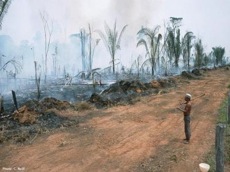 MBL senior scientist Jerry Melillo and his colleagues MBL senior scientist Jerry Melillo and his colleagues have found that carbon emissions from land-use change caused by the displacement of food crops and pastures by a global biofuels program may be twice as much as emissions from lands directly devoted to biofuels production. Picture: Chris Neill, MBL |
A report examining the impact of a global biofuels program on greenhouse gas emissions during the 21st century has found that carbon loss stemming from the displacement of food crops and pastures for biofuels crops may be twice as much as the CO2 emissions from land dedicated to biofuels production.
The study, led by Marine Biological Laboratory (MBL) senior scientist Jerry Melillo, also predicts that increased fertilizer use for biofuels production will cause nitrous oxide emissions (N2O) to become more important than carbon losses, in terms of warming potential, by the end of the century.
Using a global modeling system that links economic and biogeochemistry data, Melillo, MBL research associate David Kicklighter, and their colleagues examined the effects of direct and indirect land-use on greenhouse gas emissions as the production of biofuels increases over this century. They report their findings in the October 22 issue of Science Express.
Direct land-use emissions are generated from land committed solely to bioenergy production. Indirect land-use emissions occur when biofuels production on cropland or pasture displaces agricultural activity to another location, causing additional land-use changes and a net increase in carbon loss.
 Jerry Melillo, MBL senior scientist and Jerry Melillo, MBL senior scientist and lead author. Picture: MBL |
No major countries currently include carbon emissions from biofuel-related land-use changes in their carbon loss accounting and there is concern about the practicality of including such losses in a system designed to reduce fossil-fuel emissions. Moreover, methods to assess indirect land-use emissions are controversial. All quantitative analyses to date have either ignored indirect emissions altogether, considered those associated from crop displacement from a limited area, confused indirect emissions with direct or general land-use emissions, or developed estimates based on a static framework of today’s economy.
Using a modeling system that integrates global land-use change driven by multiple demands for land and that includes dynamic greenhouse-gas accounting, Melillo and his colleagues factored in a full suite of variables, including the potential of net carbon uptake from enhanced land management, N2O emissions from the increased use of fertilizer, environmental effects on carbon storage, and the economics of land conversion.
Further information
Indirect Emissions from Biofuels: How Important? Jerry M. Melillo, John M. Reilly, David W. Kicklighter, Angelo C. Gurgel, Timothy W. Cronin, Sergey Paltsev, Benjamin S. Felzer, Xiaodong Wang, Andrei P. Sokolov, and C. Adam Schlosser (22 October 2009). Science [DOI: 10.1126/science.1180251] (Abstract)
Source
Marine Biological Laboratory (MBL), press release, 2009-10-29.
Supplier
Marine Biological Laboratory (MBL)
Share
Renewable Carbon News – Daily Newsletter
Subscribe to our daily email newsletter – the world's leading newsletter on renewable materials and chemicals










